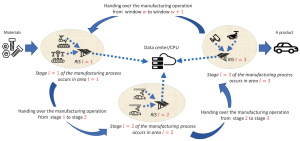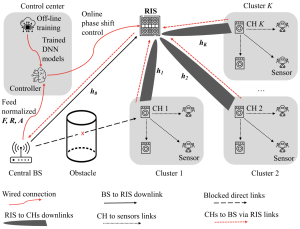As part of the work from Project “Digital twin for Industry 4”, the project team have developed deep learning techniques and advanced/timely solutions of Industrial IoTs, communication (e.g., Reconfigurable Intelligent Surface) to address the automation and smart processes in manufacturing and factory settings. The outcomes were accepted for publications in two journal papers on the highly reputed IEEE Journal of Internets of Things.
Paper 1: RIS-aided Smart Manufacturing: Information Transmission and Machine Health Monitoring


Paper 1 proposes a novel industrial Internet-of-Things framework to monitor the machine health conditions (MHCs) in a smart factory. The framework utilises reconfigurable intelligent surface (RIS) to address propagation blockages while employing a novel power mapping scheme and an autoencoder to facilitate the transmission and classification of the MHCs. Analytical and numerical analyses are then performed to study the ergodic capacity (primary information) and the MHC accuracy (secondary information) in terms of the RIS size (K) and the transmit power (P). We observe that the accuracy of detecting MHCs does not change significantly with K and P , implying that the MHC alerts can be efficiently conveyed in parallel with the primary information. By contrast, a careful choice of different power mapping levels is necessary in order to achieve the two main goals: i) reasonably high data rate for primary transmission and ii) high accuracy for secondary MHC information.
Paper 2 presents a general system framework which lays the foundation for Reconfigurable Intelligent Surface (RIS)-enhanced broadcast communications in Industrial Internet of Things (IIoTs). In our system model, we consider multiple sensor clusters co-existing in a smart factory where the direct links between these clusters and a central base station (BS) is blocked completely. In this context, an RIS is utilized to reflect signals broadcast from BS toward cluster heads (CHs) which act as a representative of clusters, where BS only has access to the statistical distribution of the channel state information (CSI). An analytical upper bound of the total ergodic spectral efficiency and an approximation of outage probability are derived. Based on these analytical results, two algorithms are introduced to control the phase shifts at RIS, which are the Riemannian conjugate gradient (RCG) method and the deep neural network (DNN) method. While the RCG algorithm operates based on the conventional iterative method, the DNN technique relies on unsupervised deep learning. Our numerical results show that the both algorithms achieve satisfactory performance based on only statistical CSI. In addition, compared to the RCG scheme, using deep learning reduces the computational latency by more than 10 times with an almost identical total ergodic spectral efficiency achieved. These numerical results reveal that while using conventional RCG method may provide unsatisfactory latency, DNN technique shows much promise for enabling RIS in ultra reliable and low latency communications (URLLC) in the context of IIoTs.

